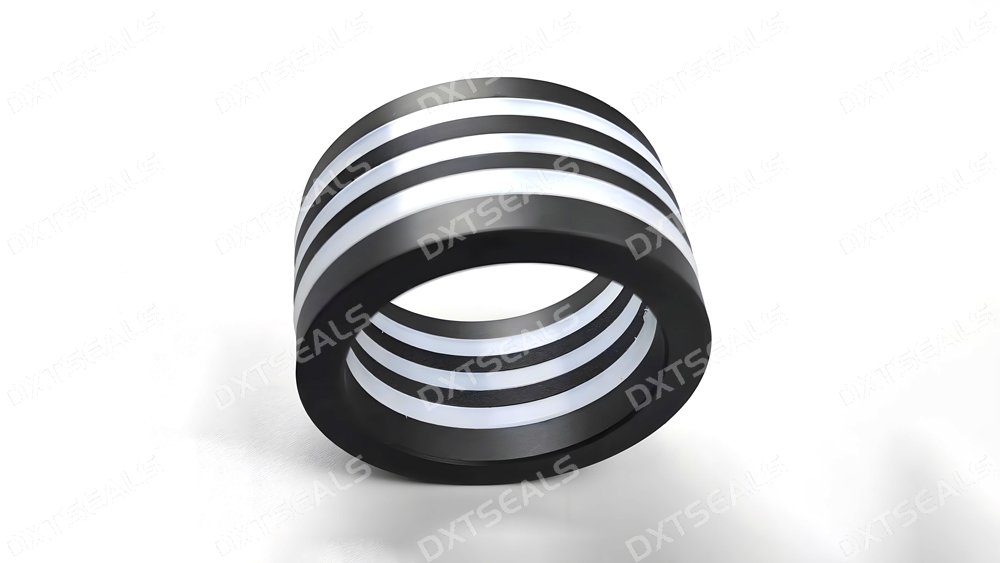
In high-performance industrial applications, the choice of plastic material can significantly impact the product's performance, durability, and cost-efficiency. PTFE, PEEK, and POM are three commonly used engineering plastics, each with distinct physical and chemical properties that suit them for specific working conditions.
This article by DXTSEALS provides a detailed comparison of PTFE (Polytetrafluoroethylene), PEEK (Polyetheretherketone), and POM (Polyoxymethylene) to help engineers and procurement teams select the right material for their applications.
🔍 At a Glance: Material Property Comparison
| Property | PTFE | PEEK | POM |
|---|---|---|---|
| Temperature Resistance | -200°C to +260°C | -50°C to +260°C | -40°C to +110°C |
| Mechanical Strength | Low | Very High | High |
| Friction Coefficient | Extremely Low | Low | Moderate |
| Chemical Resistance | Excellent | Excellent | Good |
| Dimensional Stability | Poor | Excellent | Good |
| Machinability | Fair | Moderate | Excellent |
| Cost | Moderate | High | Low |
🔹 PTFE – The King of Chemical Resistance
PTFE (Polytetrafluoroethylene) is known for its extremely low friction coefficient, non-stick properties, and unmatched chemical resistance. It is ideal for applications requiring high resistance to aggressive chemicals and high temperatures.
✔ Advantages:
-
Excellent thermal stability up to 260°C
-
Outstanding chemical inertness
-
Non-stick and anti-friction surface
-
Excellent electrical insulation
✖ Limitations:
-
Low mechanical strength and wear resistance
-
Poor dimensional stability under load
-
Difficult to bond or weld
Common Applications:
Seals, gaskets, bearings, chemical liners, non-stick coatings, electrical insulation
🔹 PEEK – High Performance Under Pressure
PEEK (Polyetheretherketone) is a premium engineering thermoplastic with exceptional mechanical strength, chemical resistance, and dimensional stability, even in extreme conditions. It's often used as a lightweight metal replacement.
✔ Advantages:
-
High tensile and compressive strength
-
Excellent resistance to heat, chemicals, and wear
-
Superior dimensional stability
-
Biocompatibility (used in medical implants)
✖ Limitations:
-
High material and processing costs
-
Limited availability compared to other plastics
Common Applications:
Aerospace and automotive components, oil & gas parts, medical devices, electrical insulators
🔹 POM – The All-Round Workhorse
POM (Polyoxymethylene), also known as acetal or Delrin®, offers good mechanical strength, low friction, and high machinability. It's cost-effective and easy to mold or machine.
✔ Advantages:
-
High stiffness and dimensional accuracy
-
Good wear resistance and low friction
-
Excellent machinability
-
Low moisture absorption
✖ Limitations:
-
Poor resistance to strong acids and bases
-
Limited temperature resistance compared to PTFE and PEEK
Common Applications:
Gears, bushings, sliders, pump components, automotive trim, consumer goods
🛠 Choosing the Right Material: Key Considerations
| Requirement | Recommended Material |
|---|---|
| Extreme chemical resistance | PTFE |
| High strength and thermal stability | PEEK |
| Budget-friendly with good strength | POM |
| Non-stick or anti-friction surface | PTFE |
| Precision machining requirements | POM |
| Harsh industrial environment | PEEK |
✅ Conclusion
Each plastic material—PTFE, PEEK, and POM—has unique properties tailored for specific industrial needs. Understanding their strengths and limitations helps ensure optimal material selection for durability, cost-effectiveness, and performance.
At DXTSEALS, we provide expert guidance and precision-machined plastic components to meet your exact specifications. Whether you require chemical-resistant PTFE seals, high-strength PEEK bushings, or cost-effective POM components, we have the right solution for your application.
📞 Contact us today to explore the best plastic material for your project.
